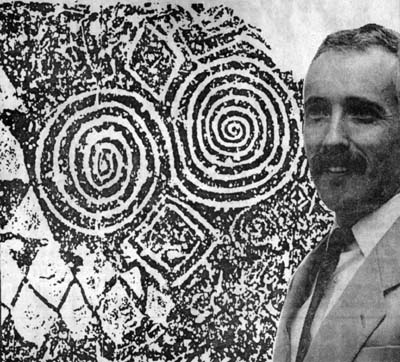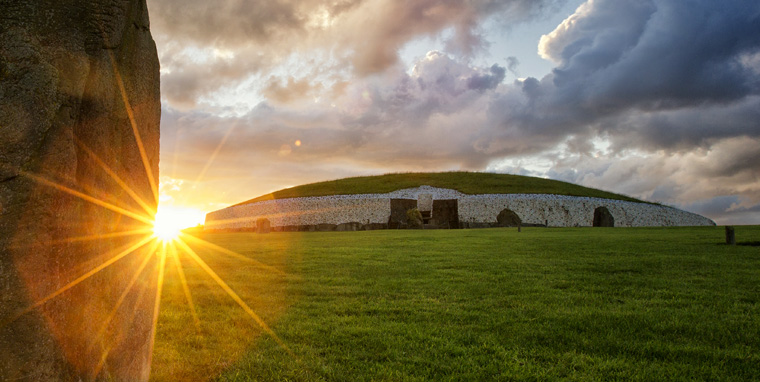An article printed in the Evening Press, 25th April 1986
Martin Cullen is probably the only artist in the world using a technique to bring ancient images alive again. Here he talks to June Considine.
They are dramatic circles of colour. They are images, ancient, belonging to a mysterious past, transcribed from rocks which have borne the chiselled imprint for 5.000 years. Stone rubbings would be a simple description of Martin Cullen's work. It would also be a total understatement. It would be an understatement which would detract from the skill and technique which has evolved over the years and which produces his dramatic and colourful reproduction of the New Grange stone engravings.
Martin Cullen began his working career as a civil engineer with Dublin Corporation. It was a safe, steady career, promising a predictable future and would have continued to do so except that this was the age of self-awareness and he found himself drawn towards the quiet, meditative philosophy of Transcendental Meditation. In his spare hours he began to train as a teacher of Transcendental Meditation and soon found himself at a crossroads faced with the decision as to whether or not he should continue with his engineering career. He gave up his job with Dublin Corporation although not without a certain amount of regret as he had enjoyed his years there.
As a natural progression to his T.M. work he became involved in the arts and began to experiment with poetry and painting. With his friend Gabriel Rosenstock he organised and mounted an unusual exhibition one which linked the past culture and art of Japan and Ireland. He illustrated a book of poetry written by Gabriel, using delicate circled strokes. The circle, he believes, is one of the most important symbols used by humans since time immemorial.
"Most pictures are based on square or rectangled shapes," he explains, "but I use a circle to create a continuation, a wholeness, a unity." He draws circles in his mind. When he talks his hands gesticulate, expounding his belief that it is a universal symbol which we have used from ancient times to link our world with the mysterious and unknown. In his illustrations the circle is used to suggest, rather than impose, an image. A fragile sunrise, wheat bending to the breeze, you see all this and more in the gentle black and white drawings.
But they belong to an earlier phase along with his poetry, which was published in an American anthology. Today he is involved in a different art form which comes about through his interest in the past in lost cultures who created their symbolic carvings on rock and stone.
While travelling around Ireland opening up new T.M. classes, he became interested in old ruins and the engraved slabs of stone within them. "When I visit a town I like to absorb its atmosphere and, one day, I visited St. Canice's Cathedral in Kilkenny. I was intrigued by the stone slabs laid along the floor which has the most beautiful carvings engraved on them. I was so impressed that I took some blank paper and crayons to take an image from the stone."
It was a clumsy attempt but it was a beginning. As his expertise grew, some of the images he took were so distinct that they had them mounted and given to friends as presents. It was when he visited Newgrange that his imagination took flight and, with the permission and encouragement of the Board of Works, he began to pursue his hobby in earnest. An estimated 200,000 tonnes of stone form this famous burial mound which has the most exciting collection of Megalithic or stone art in Western Europe.
New Grange is older than Stonehenge or the Great Pyramids of Egypt and is carbon dated to 3,300 B.C. He knew immediately that he had to take an image of the mysterious symbols engraved on the rocks.
There were problems. Firstly the stone was so old that he was afraid that if he began rubbing it would crumble. So he set about devising a method which would allow him to take an image without exerting any pressure on the stone.
Eventually, after a lot of thought and experiment, he succeeded but is reluctant to explain in detail how it works. It took too many hours at the drawing board to bring it to its present stage and he is convinced that he is the only person in the world to use it.
The paper upon which the image if the carving is taken comes from many parts of the world. It is hand-made and made from silk, so soft to the touch that it creates an instinctive urge to stroke and feel it. Japan, Tibet, Nepal, China and Switzerland are some of the 30 countries from which he gets his supply of hand-made paper and this is carefully placed over a rock within the New Grange burial chamber.
He uses the method which he invented to soften the paper so that soon it clings to the rock like a second skin. He then applies his paint, a mix of oil and wax which absorbs the images in a splash of differing colours.
Working in colour brings out the detail of these ancient engravings and the contrast of shades helps the eye to visualise this detail.
When the paper has dried it is then mounted and framed. Unfortunately, framing the picture means that one cannot touch the delicate, silken paper but the end result is a dramatic impression of spirals, diamonds, herringbones or triangles, sized to the exact measurements of the pattern of the stone.
He is convinced that the patterns on the Newgrange stones are similar to those used on Aran knits. "Isn't it interesting to think that the Aran designs, famous all over the world, have been around for 5,000 years. The similarity of some of the designs is too strong for it to be pure coincidence."
When Martin Cullen is working on a picture he is completely absorbed in what he is doing. "Often I become lost in the past and there are times, inside the narrow burial chamber, when I am working in complete darkness. Initially I tried working by torch light but the glare reflected too brightly on the white paper so it was easier to work in the natural surroundings. On such occasions I am working from pure instinct and I don't know what effect I have achieved until I bring the completed picture out into the light.
Already his unusual pictures have been bought and are on display in Washington, London and Dublin. Bord na Gaeilge have already commissioned a picture, while the Investment Bank of Ireland was the first financial institution to display his work. He now plans to mount and exhibition of his work in New York, Canada, Japan and Australia. During the recent St. Patrick's Day celebrations in America one of the paintings was presented to Tip O'Neill.
But before then, an exhibition has been organised from June 10-28 at Kilcock Art Gallery where up to 35 of these unusual paintings will be on display to Irish viewers. They will feature designs from the stones at Newgrange and promise a view of ancient traditions presented through a unique and colourful medium.
What started off as a hobby has now become a full-time involvement and, once again, he finds that the direction of his life is changing. "If you don't take a chance and do certain things at certain stages of your life you become frustrated," he believes and is now channelling his considerable energies into organising his exhibitions.
"I don't believe I could find the peace and solitude of Newgrange anywhere else in Ireland", he says. "And there is so much yet to explore in this natural phenomenon which is still standing today after 5,000 years." His paintings, with their spiralling dashes of colour, are a direct link to that past a reminder that are, like our human incomprehension of life's circle, will always span the barriers of time.
Boyne Valley Private Day Tour
 Immerse yourself in the rich heritage and culture of the Boyne Valley with our full-day private tours.
Visit Newgrange World Heritage site, explore the Hill of Slane, where Saint Patrick famously lit the Paschal fire.
Discover the Hill of Tara, the ancient seat of power for the High Kings of Ireland.
Book Now
Immerse yourself in the rich heritage and culture of the Boyne Valley with our full-day private tours.
Visit Newgrange World Heritage site, explore the Hill of Slane, where Saint Patrick famously lit the Paschal fire.
Discover the Hill of Tara, the ancient seat of power for the High Kings of Ireland.
Book Now



